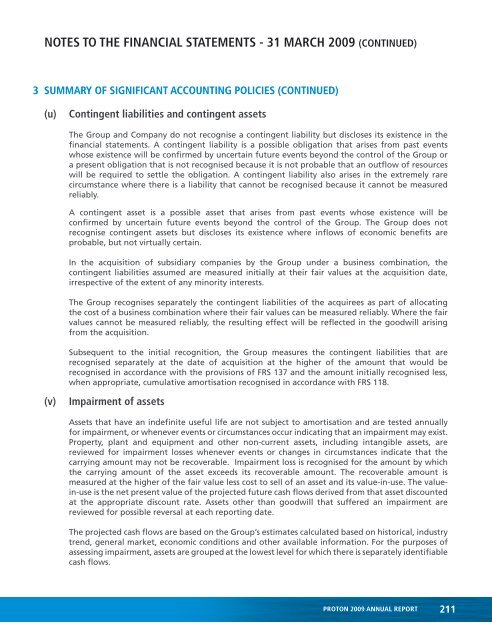Operations Review - ChartNexus
Operations Review - ChartNexus
Operations Review - ChartNexus
Create successful ePaper yourself
Turn your PDF publications into a flip-book with our unique Google optimized e-Paper software.
NOTES TO THE FINANCIAL STATEMENTS - 31 MARCH 2009 (CONTINUED)<br />
3 SUMMARY OF SIGNIFICANT ACCOUNTING POLICIES (CONTINUED)<br />
(u) Contingent liabilities and contingent assets<br />
The Group and Company do not recognise a contingent liability but discloses its existence in the<br />
financial statements. A contingent liability is a possible obligation that arises from past events<br />
whose existence will be confirmed by uncertain future events beyond the control of the Group or<br />
a present obligation that is not recognised because it is not probable that an outflow of resources<br />
will be required to settle the obligation. A contingent liability also arises in the extremely rare<br />
circumstance where there is a liability that cannot be recognised because it cannot be measured<br />
reliably.<br />
A contingent asset is a possible asset that arises from past events whose existence will be<br />
confirmed by uncertain future events beyond the control of the Group. The Group does not<br />
recognise contingent assets but discloses its existence where inflows of economic benefits are<br />
probable, but not virtually certain.<br />
In the acquisition of subsidiary companies by the Group under a business combination, the<br />
contingent liabilities assumed are measured initially at their fair values at the acquisition date,<br />
irrespective of the extent of any minority interests.<br />
The Group recognises separately the contingent liabilities of the acquirees as part of allocating<br />
the cost of a business combination where their fair values can be measured reliably. Where the fair<br />
values cannot be measured reliably, the resulting effect will be reflected in the goodwill arising<br />
from the acquisition.<br />
Subsequent to the initial recognition, the Group measures the contingent liabilities that are<br />
recognised separately at the date of acquisition at the higher of the amount that would be<br />
recognised in accordance with the provisions of FRS 137 and the amount initially recognised less,<br />
when appropriate, cumulative amortisation recognised in accordance with FRS 118.<br />
(v) Impairment of assets<br />
Assets that have an indefinite useful life are not subject to amortisation and are tested annually<br />
for impairment, or whenever events or circumstances occur indicating that an impairment may exist.<br />
Property, plant and equipment and other non-current assets, including intangible assets, are<br />
reviewed for impairment losses whenever events or changes in circumstances indicate that the<br />
carrying amount may not be recoverable. Impairment loss is recognised for the amount by which<br />
the carrying amount of the asset exceeds its recoverable amount. The recoverable amount is<br />
measured at the higher of the fair value less cost to sell of an asset and its value-in-use. The value-<br />
in-use is the net present value of the projected future cash flows derived from that asset discounted<br />
at the appropriate discount rate. Assets other than goodwill that suffered an impairment are<br />
reviewed for possible reversal at each reporting date.<br />
The projected cash flows are based on the Group’s estimates calculated based on historical, industry<br />
trend, general market, economic conditions and other available information. For the purposes of<br />
assessing impairment, assets are grouped at the lowest level for which there is separately identifiable<br />
cash flows.<br />
PROTON 2009 ANNUAL REPORT<br />
211

















